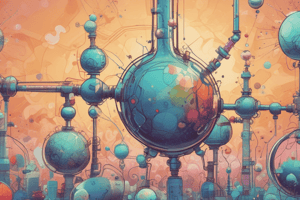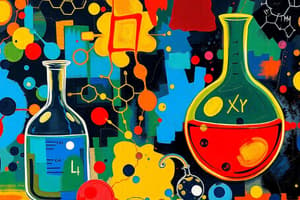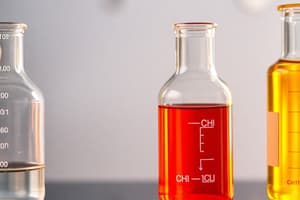Podcast
Questions and Answers
What is the primary function of a catalyst in a chemical reaction?
What is the primary function of a catalyst in a chemical reaction?
- To absorb energy necessary to change the position of equilibrium
- To increase the reaction rate without changing the equilibrium state (correct)
- To alter the chemical composition of the reactants
- To reduce the activation energy of the reaction
What happens to the physical properties of a catalyst after a reaction?
What happens to the physical properties of a catalyst after a reaction?
- They may be changed, but not consumed (correct)
- They remain unchanged
- They are completely destroyed
- They are permanently altered
What is meant by the 'selectivity' of a catalyst?
What is meant by the 'selectivity' of a catalyst?
- The ability to accelerate both forward and backward reactions
- The ability to change the chemical composition of reactants
- The ability to alter the thermodynamic properties of a reaction
- The ability to induce the formation of particular products (correct)
What is the effect of a catalyst on the equilibrium state of a reaction?
What is the effect of a catalyst on the equilibrium state of a reaction?
What is an example of a positive catalytic process?
What is an example of a positive catalytic process?
What is an example of a negative catalytic process?
What is an example of a negative catalytic process?
What is the role of a catalyst in terms of energy?
What is the role of a catalyst in terms of energy?
What is true about the chemical composition of a catalyst after a reaction?
What is true about the chemical composition of a catalyst after a reaction?
What is the significance of a small quantity of catalyst in a reaction?
What is the significance of a small quantity of catalyst in a reaction?
What is the role of a catalyst in a reaction?
What is the role of a catalyst in a reaction?
What is the purpose of a promoter in a catalytic reaction?
What is the purpose of a promoter in a catalytic reaction?
What is the effect of increasing the temperature on a catalyst?
What is the effect of increasing the temperature on a catalyst?
What is the characteristic of a catalyst that enables it to accelerate numerous reactions with a limited quantity?
What is the characteristic of a catalyst that enables it to accelerate numerous reactions with a limited quantity?
What is the significance of anhydrous aluminium chloride in the Friedel-Craft reaction?
What is the significance of anhydrous aluminium chloride in the Friedel-Craft reaction?
What is the difference between a catalyst and a promoter?
What is the difference between a catalyst and a promoter?
What is the primary role of a catalyst in a reaction?
What is the primary role of a catalyst in a reaction?
What is the result of a catalyst being present in a reaction?
What is the result of a catalyst being present in a reaction?
What is the term for substances added in small quantities to enhance a catalyst's efficiency?
What is the term for substances added in small quantities to enhance a catalyst's efficiency?
How does the surface area of a catalyst influence the reaction rate?
How does the surface area of a catalyst influence the reaction rate?
What is the purpose of copper ion in the oxidation of Na2SO3?
What is the purpose of copper ion in the oxidation of Na2SO3?
Which of the following is not a key requirement for industrial catalysts?
Which of the following is not a key requirement for industrial catalysts?
What is the correct priority order for target quantities in industrial catalysts?
What is the correct priority order for target quantities in industrial catalysts?
What is a catalytic promoter?
What is a catalytic promoter?
How does temperature influence the catalytic power of a catalyst?
How does temperature influence the catalytic power of a catalyst?
What is the temperature at which a catalyst's catalytic activity is maximum?
What is the temperature at which a catalyst's catalytic activity is maximum?
Why is the reaction faster when MnO 2 is present as a powder than as granules?
Why is the reaction faster when MnO 2 is present as a powder than as granules?
What is the order of priority for target quantities in industrial catalysts?
What is the order of priority for target quantities in industrial catalysts?
What is the main method for describing the role of catalysts in chemical reactions?
What is the main method for describing the role of catalysts in chemical reactions?
What is the primary requirement for an industrial catalyst?
What is the primary requirement for an industrial catalyst?
What is the purpose of the catalytic cycle?
What is the purpose of the catalytic cycle?
What is the effect of increasing the surface area of a catalyst?
What is the effect of increasing the surface area of a catalyst?
What is the term for the reduction of activation energy due to the addition of a foreign substance?
What is the term for the reduction of activation energy due to the addition of a foreign substance?
What enables a catalyst to remain unchanged at the end of a reaction?
What enables a catalyst to remain unchanged at the end of a reaction?
What is the ability of a catalyst to induce the formation of particular products?
What is the ability of a catalyst to induce the formation of particular products?
In the Haber's process, what substance enhances the activity of finely divided iron?
In the Haber's process, what substance enhances the activity of finely divided iron?
What is a characteristic of a catalytic cycle?
What is a characteristic of a catalytic cycle?
How does the surface area of a catalyst influence the reaction rate?
How does the surface area of a catalyst influence the reaction rate?
What is the role of a catalytic promoter in a reaction?
What is the role of a catalytic promoter in a reaction?
How does temperature influence the catalytic power of a catalyst?
How does temperature influence the catalytic power of a catalyst?
What is true about the addition of a catalyst in small amounts?
What is true about the addition of a catalyst in small amounts?
Flashcards are hidden until you start studying
Study Notes
Introduction to Catalysis
- Catalysis is the key to chemical transformations, where a catalyst is a substance that alters the chemical rate without changing its own chemical composition when added in small amounts.
Types of Catalysts
- A catalyst can accelerate both forward and backward reactions in the same proportion, e.g., HCl accelerates hydrolysis of ester and esterification of alcohol.
- A catalyst can also accelerate only the forward chemical reaction, e.g., catalytic decomposition of H2O2 in presence of metals.
- In some cases, a catalyst can accelerate the backward reaction, e.g., presence of glycerol as a catalyst.
General Characteristics of Catalysis
- A catalyst does not change, consume, deactivate, or destroy at the end of the reaction, but its physical properties may change.
- A small quantity of catalyst is generally sufficient to catalyze almost unlimited reactions, making it economically important.
- The rate of reaction is directly proportional to the concentration of the catalyst in many homogeneous catalytic reactions.
- A catalyst cannot initiate the reaction, but only increases or decreases the overall rate of reaction.
Catalytic Promoters
- Substances that increase the efficiency of catalysts when mixed in small quantities are called promoters or activators.
- Examples include molybdenum in Haber's process for the synthesis of ammonia and chromic oxide in the manufacture of methyl alcohol from water gas.
Influence of Temperature
- Increasing temperature initially increases the catalytic power of a catalyst, but after a certain temperature, its power begins to decrease.
- Each catalyst has an optimum temperature at which its catalytic activity is maximum.
Effect of Surface Area
- The more finely divided (powdered) the catalyst is, the faster the reaction happens.
- For example, the decomposition of hydrogen peroxide in presence of MnO2 as catalyst is much faster when the catalyst is present as a powder than as granules.
Requirements of Industrial Catalysts
- A catalyst must have a realistic rate of reaction (activity), achieve an acceptable selectivity for the desired products, and be sufficiently stable under operating conditions.
- The priority order for target quantities is selectivity > stability > activity.
Catalytic Cycle
- The catalytic cycle is a multistep reaction mechanism that involves a catalyst and is usually written as a sequence of chemical reactions in the form of a loop.
- Catalysts are regenerated, and catalytic cycles describe the role of catalysts in chemical reactions.
Studying That Suits You
Use AI to generate personalized quizzes and flashcards to suit your learning preferences.




